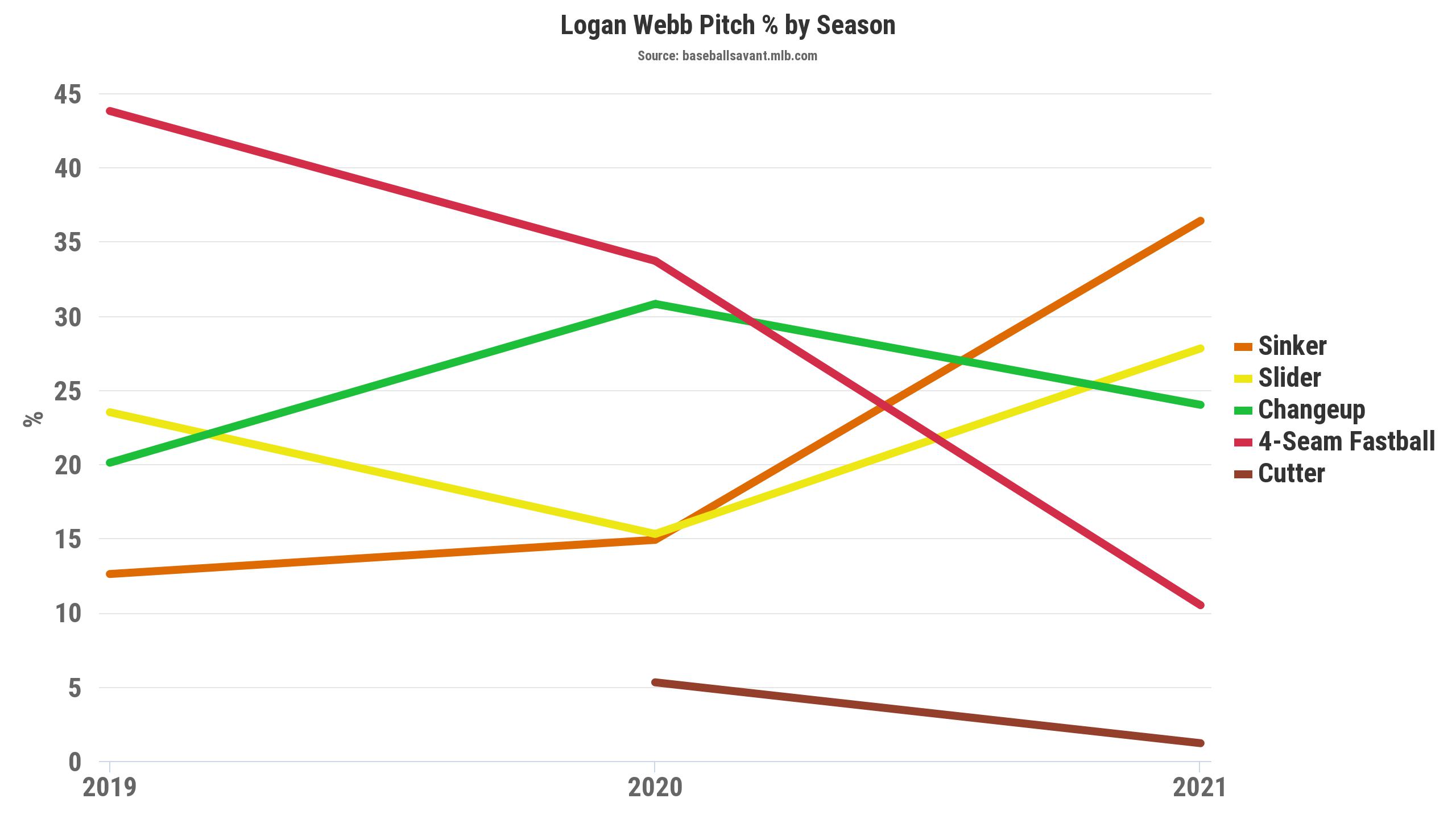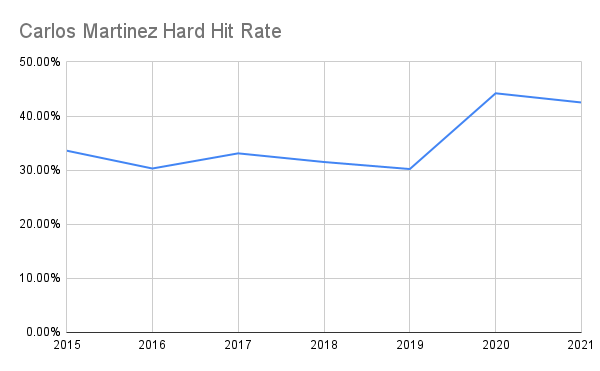The Giants’ Logan Webb has been a revelation this season, posting a 2.64 ERA while striking out a quarter of the batters he’s faced and lowering his walk rate. The stuff itself hasn’t seemed all too different– his fastball is up 0.1 miles per hour and his movement is generally in line with last year’s on most of his pitches.
Instead, Webb has changed his pitch mix significantly, ditching a lot of his four-seamers (.410 xWOBA in 2020) in favor of a lot more sinkers (.276 xWOBA in 2020).

Webb’s opponent’s launch angle, whiff rate, and hard-hit rate are all down significantly from last season. Of course, it’s not always as simple as ditching pitches that aren’t working in favor of more effective ones. Sometimes though, it is as simple as that.
I’m no pitching coach and won’t pretend here to be one. Instead, I’ll point out that it’s odd to see the Cardinals on so many of our Pitcher List leaderboards with elite pitches by CSW% that aren’t using them.
As a reminder, CSW% is called strikes plus whiffs and is a good indicator of the effectiveness of particular pitches. It stands to reason that if you have an elite pitch, it’s one you want to throw a lot. There are obviously many factors at play, some quantifiable (e.g., other pitches in the repertoire may be even more effective), and others not (e.g., player comfort with throwing the pitch).
Several Cardinal pitchers stand out with elite CSW% on their pitches that are not thrown as often as their peers around the league. Would any of them benefit from a Logan Webb-esque pitch mix change?
Alex Reyes, Slider, 44.9% CSW, 26.9% of Pitches
Reyes’ use of his slider is lower than anyone in MLB this season with a 41.5% CSW or higher (min. 50 IP). To give some context on how effective this pitch is, it sits right behind Jacob DeGrom’s 45.2% CSW on the slider.
Reyes instead throws his four-seamer most of the time, which is also an elite pitch itself, just not as effective as that slider. Walks have always been the big concern with Reyes, and that has continued in 2021. While he’s struck out 29% of the batters he’s faced, Reyes has also walked 16% of them. That could indicate that the slider isn’t being used as often because Reyes has trouble controlling it and therefore needs to rely on his four-seamer more often, even if it’s less effective as a pitch. But that doesn’t seem to be the case, as he throws his four-seamer and slider for an exactly identical 48% of the time in the zone.
Once again, there could be myriad reasons why Reyes doesn’t throw the slider more often. After returning from Tommy John surgery in 2017, Reyes had to have another tendon surgery on his back in early 2018. The injuries have been tough to start the former top prospect’s pitching career and so we can’t minimize the potential impacts on health his various pitch arsenals may have. It does, however, seem that the slider, for now, is significantly more effective and without much obvious downside in a vacuum.
Kwang-hyun Kim, Splitter, 25.1% CSW, 11.5% of Pitches
Much like his teammate Alex Reyes’ slider, Kim’s splitter ranks near the top of the leaderboard in terms of CSW%, but he throws it the third-least of anyone with a CSW of 25% or greater on the pitch. Kim’s lack of use of the pitch is a bit more readily explainable, however. His slider (29.5% CSW) and four-seamer (25.5% CSW) each are more effective by that measure, and they’re the two pitches he throws more often than the splitter.
Kim’s appearance on the list brings an important distinction to the discussion. The sample of pitchers who have elite pitches that are not thrown as often as others is, by its definition, a biased one. Naturally, pitchers with elite offerings will be over-represented in the list, as is the case with Kim’s splitter. It’s not as easy to suggest that Kim should throw the splitter more, since the two pitches he throws more often are more effective (at least, in terms of CSW%). In fact, Kim’s appearance on the list is more of a testament to the fact that he has so many good pitches in his arsenal.
Kim’s CSW and strikeout percentages are up this season, yet the results haven’t matched his stellar 2020. Partially his walks are up, but his .216 BABIP in 2020 wasn’t likely sustainable, and this year has regressed to .269 (still below league average). Like his teammate Reyes, Kim’s walks are the main culprit holding his performance back (8% in 2021).
Carlos Martinez, Sinker, 16.8% CSW, 14.4% of Pitches
It’s been a rough few of seasons for the previously-excellent Cardinal pitcher, who never surpassed an ERA of 4 in his career before posting 9.90 and 6.01 in the past two seasons.
Much like Kim, Martinez’s sinker usage is more a function of his other pitches garnering a higher rate of CSW%. Despite having the 24th-highest CSW% on the sinker in the majors this year, his other, more prominent offerings generate more called and swinging strikes on a per-pitch basis. In his past two seasons, the main issue has been, perhaps unsurprisingly, that hitters are just hitting Martinez hard:

Those balls have also left the yard at pretty extreme rates, when compared to his 2018 and 2019 seasons. If batters are going to make hard contact, as they are against Martinez, it may make sense to at least get those balls on the ground more often. His excellent sinker provides a possible path to that, generating just 9.3% fly balls, whereas he averages 28% fly balls for his career.
Both Kim and Martinez’s pitch mixes are justifiable by CSW%, as they have other offerings with even better results. Arsenals are complicated things to manage, and there could be some benefit to mixing those pitches in more often, especially in Martinez’s case with his extreme groundball rates on the pitch. In other cases, such as Reyes’, an increased slider usage may prove to garner better results and less contact from hitters and a worthy experiment.
Overall, it’s incredible to see the Cardinals struggle with pitching this season. They’ve posted the third-worst xFIP in the major leagues yet have several pitchers with elite offerings. At the same time, those pitchers’ “worst” pitch by CSW% is often one of the best versions of that particular pitch. Pitch mix may be one piece to the puzzle, but it’s clear there is a lot of room for stronger results even with the rotation and bullpen they have in place.

